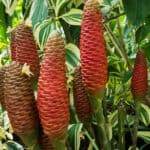White Sapote Overview
White sapote (Casimiroa edulis) is a peach-sized fruit in the citrus family, Rutaceae, although its taste and texture scream otherwise. The name, “sapote,” is misleading, as the fruit is not actually in the Sapotaceae family; its name is derived from the Nahuatl word, “tzapotl,” which refers to any soft, sweet fruit. It is a pale greenish-yellow in external color when ripe, and an eggshell white internally. White sapote flowers are clustered and unassuming, decorating evergreen trees and ranging in color from white to pale greenish-yellow. The fruit contains one to five seeds, each approximately the size of an almond.
White sapote flesh has a creamy, nearly custard-like texture, and tastes of an indulgent blend of banana, pear, and vanilla. It is most enjoyable with good company while walking along a rural, oceanside road after procuring from a local fruit stand.
Introduction to the Mainland U.S.
White sapote is native to to Mexico and was introduced to California by Franciscan monks in the early 1800s. It was popularized as an ornamental tree in California during the 1900s, and is frequently used for landscaping in Southern California. There is a small commercial market for white sapote in Florida, but due to its introduction to the contiguous U.S. as ornamental greenery, people are often unfamiliar with the decadence of the fruits; consequently, they frequently (and appallingly) go unpicked and fall to the ground to rot.
Healing Properties of White Sapote
Consuming white sapote flesh is thought to lessen joint pain and inflammation. Some extracts made from the leaves and seeds are thought to be effective in treating hypertension, anxiety, insomnia, and cramping.
Other extracts from the leaves, bark, and seeds have been shown to have a mild sedative effect and may possess antispastic and anticonvulsive properties. It is important to note that these treatments have not been tested by the FDA, and you should do additional research prior to utilizing white sapote to treat any disorders. Additionally, there is some research indicating that raw seeds are toxic if consumed orally.
Propagating & Planting White Sapote
White sapote will grow anywhere that citrus is successfully cultivated, although it is known to thrive in tropical and subtropical areas, as long as the humidity is not too extreme. Choose an area for planting where the soil is well-drained.
A grafted white sapote tree will produce fruit sooner (3-4 years) than one grown from seed (6-8 years). While cuttings are rather difficult to root, many find success with grafting trees or simply purchasing young trees (2-4 feet) from a nursery. It is recommended that rootstocks used for grafting are grown in place for about three years, and the scion is grafted upon first signs of rootstock growth in the spring.
Although better fruit typically comes from budded or grafted trees, some find success when planting from seeds. Use fresh white sapote seeds that have been cleaned of flesh and allowed to dry. When planting from seed or potted tree, give the tree at least a 25 foot radius from other trees or structures, as it can grow over 50 feet tall, and its roots will branch out respectively.
Caring for White Sapote

In subtropical to temperate or arid regions, white sapote trees should be watered immediately after planting, then every other day for the first week, and one to two times per week for about two months. Young trees should be watered during dry periods of five days or longer. They do not require water in excess during wet seasons.
In more tropical areas with higher humidity and more frequent rainfall, the trees will require little to no extra watering. It is better to err on the side of inadequate water than excess water, as they are susceptible to root rot.
The trees prefer full sun and well-drained soil, although they are known to be hardy and able to endure both mild frost and drought. In drier, hotter areas, the trees will benefit from partial shade. They do not require any extra fertilizer or compost and are able to flourish in a variety of soil types, assuming the soil does not hold extra moisture after rains.
The fruits are susceptible to fruit flies if left on the tree to ripen. There may be a subtle exchange of flavor for bugless fruit, but it is worth clipping the fruit off just a bit early to ensure that you beat the flies to the tasty treat. Additionally, scale bugs have been known to damage the leaves.
Harvesting White Sapote
Generally, white sapote is ready to harvest six to nine months after the tree blossoms. The fruits ripen from late fall to spring, and harvesting typically takes place in the spring or summer. Trees in some areas, particularly those that show less significant seasonality, will fruit year-round. Fruit from the later blooms, however, is often of poorer quality.
White sapote bruises easily. Mature fruits should be harvested prior to falling, as bruised fruits will rot and/or become bitter in bruised areas. They can be harvested well in advance of full ripeness but should be mature in size before coming off the tree.
When harvesting, be sure to clip the fruit from the branch with some of the stem attached. Pulling the fruit off the stem will encourage bruising and rotting. When the fruit is fully ripe & ready to eat, the stem will naturally fall off.
Storing and Indulging in White Sapote
White sapote with the stem intact should be stored at room temperature until ripe. It will be slightly soft, not unlike the feel of a ripe avocado when it is ready to be eaten. Ripeness will also be indicated by the loss of the remainder of the stem. Once ripe, white sapote will hold in the refrigerator for about two weeks.
The fruit is delicious when sliced like an apple and eaten straight from the hand. Avoid eating the skin, as it has a bitter flavor, and remember to spit out the seeds!
If you are interested in getting a bit more creative, white sapote’s sweet, banana-y flavor makes it a delectable flavor for desserts, such as ice cream, sorbets, or smoothies. Some people have even dabbled in white sapote cookies and marmalades.




























































